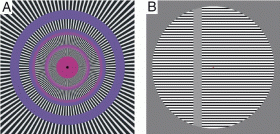November 11, 2008 feature
Optical illusions: caused by eye or brain?

When viewing the famous optical illusion painting Enigma by Isia Leviant, many people claim to see motion within the colored circles moving against the black and white striped background. Although this optical illusion has been known for a long time, its physiological origins are still unknown.
For the past 200 years, researchers have debated whether the illusion of motion in a static image is caused by mechanisms in the eye, in the brain, or by a combination of both. Because measuring these kinds of physiological responses is difficult, no study has successfully measured direct and tightly timed correlations between a kinetic illusion and a physiological precursor.
But recently, a team of researchers from the Barrow Neurological Institute in Phoenix, Arizona, and the University of Vigo in Vigo, Spain, has found a direct correlation between illusory motion and microsaccades, which are tiny eye movements that involuntarily occur several times per second during visual fixation. Although the team hasn’t determined the neural mechanism behind the correlation, the finding rules out the hypothesis that the origin of the kinetic optical illusion is purely cortical.
“These results revealed a direct link between the eye motions and the perception of illusory motion, and ruled out the hypothesis that the Enigma illusion originates solely in the brain,” Susana Martinez-Conde, Director of the Laboratory of Visual Neuroscience at the Barrow Neurological Institute, told PhysOrg.com. “Our study provides a possible explanation for an entire family of visual illusions central to the fields of visual art and visual science. It would be quite unexpected if Enigma turned out to be the only motion illusion affected by eye movements.”
In tests, the researchers tracked subjects’ eye positions with a video-based eye movement monitor, while asking the subjects to release a button when they perceived fast movement, and press the button when they perceived slow to no movement (no illusion). The results showed that microsaccade rates increased shortly before subjects reported seeing fast movement. Conversely, microsaccade rates decreased shortly before subjects reported seeing slower movement.
These findings show a direct correlation between microsaccades and the perception of illusory motion, but the researchers also wanted to know if microsaccades might actually cause the illusion. To investigate this possibility, the team tested an alternative hypothesis: that, rather than microsaccades causing the illusion, the illusion causes both the microsaccades and subjects’ perceived illusory motion (reported by pressing and releasing the button).
In this control test, subjects were shown real moving images and asked to indicate changes in motion. Results from the eye movement monitor showed that, unlike when viewing the static images, subjects’ microsaccade rates did not increase before transitions to faster movement, nor did microsaccade rates decrease before transitions to slower movement. Further, microsaccade rates actually decreased after a change in motion, whether faster or slower. These findings show that perceptual motion changes do not cause changes in microsaccade rate, answering the first part of the alternative hypothesis.
From this data, the researchers could also determine the time delay between the actual change in motion and the subjects’ reported change in motion, which was about 520 microseconds. Because the measured changes in microsaccade rates occurred about 740 microseconds before this reported change, the researchers concluded that microsaccades may potentially drive the illusion, but not the other way around.
If microsaccades do indeed drive the Enigma illusion, future research will still need to investigate whether the cause is direct or indirect, and what neural mechanisms may be at its root. In previous studies, researchers have proposed a few possibilities based on the idea of “phi movement,” which is the illusion of apparent motion caused by switching off one stimulus and immediately turning on another in close proximity.
For example, microsaccades may cause parts of the image to shift, which could cause the black and white lines to continuously reverse, resulting in phi movement. Another possibility is that microsaccades may displace after-images of the black and white stripes, also causing phi movement. A more complex eye-brain explanation is also possible, and the researchers will continue investigating this intriguing illusion.
By learning more about how optical illusions work, Martinez-Conde and her colleagues hope to understand more about the brain, and how it creates our sensory reality.
“Visual illusions are defined by the dissociation between physical reality and subjective perception of an object or event,” she said. “When we experience a visual illusion, we may see something that is not there, or fail to see something that is there, or even see something different from what is there. Because of this dissociation between perception and reality, visual illusions demonstrate the ways in which the brain can fail to recreate the physical world. By studying these failings, we can learn about the computational methods that the brain uses to construct visual experience. Presently, one of the most important tools used by neuroscientists to understand how the brain creates its sense of reality is the visual illusion.
“The findings from our recent study may moreover help us to understand the neural mechanisms underlying motion perception, both in the normal brain, and in patients with brain lesions that affect the perception of motion,” she said. “Also, they could help design future neural prosthetics for patients with brain damage.”
More information: Troncoso, Xoana G.; Macknik, Stephen L.; Otero-Millan, Jorge; and Martinez-Conde, Susana. “Microsaccades drive illusory motion in the Enigma illusion.” Proceedings of the National Academy of Sciences, October 14, 2008, vol. 105, no. 41, 16033-16038.
Copyright 2008 PhysOrg.com.
All rights reserved. This material may not be published, broadcast, rewritten or redistributed in whole or part without the express written permission of PhysOrg.com.





















